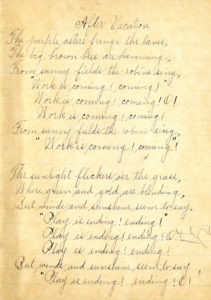 In the AAS Penmanship Collection, a group of penmanship exercises and copy books by various students, there is a poem titled “After Vacation” by an unknown pupil from the Parkerville School in Westford, Massachusetts. The poem is on the first page of one of the mostly-filled volumes and captures an adieu to summer with the refrain: “Work is coming! Coming! O!….Play is ending! Ending! O!”
In the AAS Penmanship Collection, a group of penmanship exercises and copy books by various students, there is a poem titled “After Vacation” by an unknown pupil from the Parkerville School in Westford, Massachusetts. The poem is on the first page of one of the mostly-filled volumes and captures an adieu to summer with the refrain: “Work is coming! Coming! O!….Play is ending! Ending! O!”
The bittersweet (but lovely!) poem has put us in the mood for an archive-inspired back-to-school supplies hunt. We hope you will enjoy this selection of items pulled from several of our favorite collections and worked against a (contemporary) school’s supply list. We tried to find versions of composition books, erasers, packs of pencils, cases, and other items which (we hope) will make us leader of the class.
Let us know if there is anything missing which you’d like to see checked off!
Are pens and pencils near the top of your list? We got that. We have a set of nine quill pens in a box that slides open; the “Congress quill pens” were manufactured by E. De Young in mid-nineteenth-century New York.
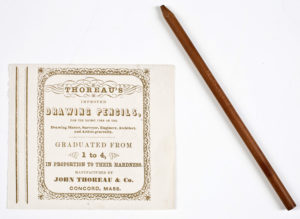 If a good name-brand is your game, might we interest you in the pencil we have made in Concord by Thoreau & Co. (yes, the same family!) This pencil and label for “Thoreau’s improved drawing pencils” is from a set of four (we alas, have one) but is “for the nicest uses of the drawing master, surveyor, engineer, architect, and artists generally: Graduated from 1 to 4, in proportion to their hardness.”
If a good name-brand is your game, might we interest you in the pencil we have made in Concord by Thoreau & Co. (yes, the same family!) This pencil and label for “Thoreau’s improved drawing pencils” is from a set of four (we alas, have one) but is “for the nicest uses of the drawing master, surveyor, engineer, architect, and artists generally: Graduated from 1 to 4, in proportion to their hardness.”
Do you require a box to store your supplies? You might find this one appealing – the Louis Maurer Archival Collection dating from 1850-1932 contains boxes (and as you can see, boxes of boxes!) of material. Pictured here is also a package of Charles Currier Lithographic crayons, No. 2 with the crayons and a label as well as the wooden toolbox; an inventory of the items contained can be found here.
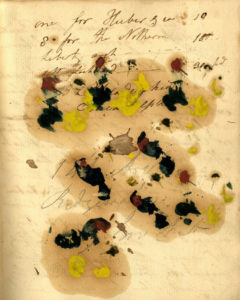 Crayons not enough to satisfy the fine art supplies you demand this year? Might you also need some blotter paper? We have some paints in an account notebook from Bass Otis (1784-1861) which is a DIY-version. Otis, a Philadelphia artist and portrait-painter, as well as lithographer, took notes in the volume on artistic-technique in addition to using some inner pages for oil-testing.
Crayons not enough to satisfy the fine art supplies you demand this year? Might you also need some blotter paper? We have some paints in an account notebook from Bass Otis (1784-1861) which is a DIY-version. Otis, a Philadelphia artist and portrait-painter, as well as lithographer, took notes in the volume on artistic-technique in addition to using some inner pages for oil-testing.
Need inspiration for your workbooks, nameplates, desk tags, or other classroom belongings? We’ve got you covered – literally. Presented here are examples from the copybook cover collection. The Society has three boxes of copy, drawing or writing book covers – many with aids for learning such as multiplication or mathematical tables and a place for the pupil to inscribe his or her name (such as the hand-colored example, bottom). These printed wrappers were originally from blank composition books which were made into their own collection because of their rich printed imagery. You see these covers at work protecting content in the Society’s penmanship collection. 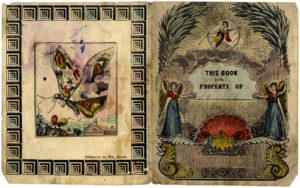
Have a special interest in portability? We don’t have laptops, cases or tablets, but we do have a mobile device – this Civil War envelope shows the Soldiers’ Portable Camp Writing Case printed by J.M. Whittemore & Co. in Boston during the Civil War years. The image on the envelope shows illustrated details for writing instrument and paper storage (and how it rolls up).
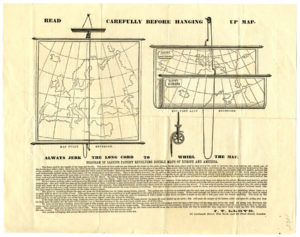 Need a way to safely display your hanging posters? This 1865 advertisement for “Diagram of Lloyd’s patent revolving double maps of Europe and America” is pretty handy and illustrates in detail how to jerk the cord to roll the map.
Need a way to safely display your hanging posters? This 1865 advertisement for “Diagram of Lloyd’s patent revolving double maps of Europe and America” is pretty handy and illustrates in detail how to jerk the cord to roll the map.
Want to go old school with your supplies? Do you require a slate? We have a ca. 1811 one which has its original sponge eraser. This example with marbled boards is over a sheep-back spine; there are also faded chalk notes with sums. Make sure to do your own work!
Teachers: are you looking for stickers or other incentives for your students? Look no further than our reward of merit collection! We have lovely ones filled in for students and blank ones ready for you to heap praise on your favorites for anything from spelling to punctuality. Several are handmade beauties, such as this top one, “Mr. Moody A. Pilsbury has made very good improvement in learning since he has attended school, for which he is entitled to much praise. – Martha Prichard”
….while another example here presented on the bottom to Arthur Holt by his teacher Edna F. Pike shows a boy chased up a fruit tree by a dog – there has to be an easier way to get an apple for your teacher, Arthur!
With the summer staff returning to college (and before the new crop of academic fellows join us in the reading room this fall) we enjoyed collecting items for our own mini-back-to-school. Yes, the bug bites us all. And no, fear not! There won’t be a quiz later!

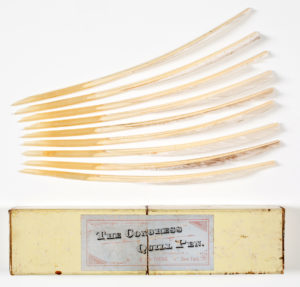
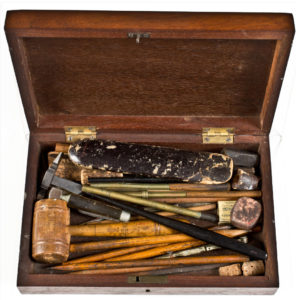
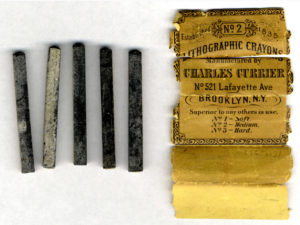
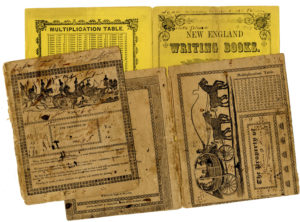
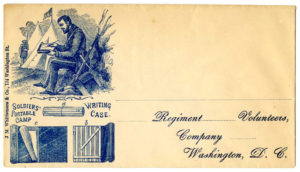
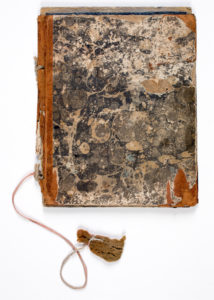
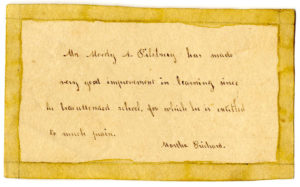
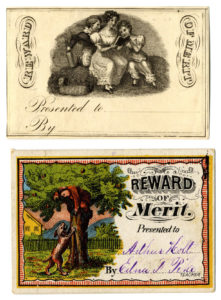
What a wonderful array from so many collections!